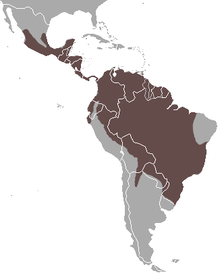Tayra
| Tayra | ||||||||||||
|---|---|---|---|---|---|---|---|---|---|---|---|---|

Tayra in the Pantanal (Brazil) |
||||||||||||
| Systematics | ||||||||||||
|
||||||||||||
| Scientific name of the genus | ||||||||||||
| Eira | ||||||||||||
| CH Smith , 1842 | ||||||||||||
| Scientific name of the species | ||||||||||||
| Eira barbara | ||||||||||||
| ( Linnaeus , 1758) |
The Tayra or Hyrare ( Eira barbara ) is a species of carnivore from the Marten family (Mustelidae) living in Central and South America . It is the only representative of the genus Eira and closely related to the real marten ( Martes ) that also occur in Europe .
features
Tayras are reminiscent of weasels in their physique , but they are significantly larger. The trunk is elongated and slender, the limbs are relatively short. The short and dense fur is dark brown; the head is somewhat lighter than the rest of the body, and there is usually a yellow or white spot on the throat. There is also a light morph, with this the fur is grayish in color and the head is darker. The tail is long and bushy. These animals reach a head body length of 56 to 68 centimeters, to which a 38 to 47 centimeter tail length come, and their weight is 4 to 5 kilograms.
distribution and habitat
Tayras live in Central and South America . Their distribution area extends from southern Mexico to Paraguay and northern Argentina . Their habitat are mainly tropical rainforests .
Way of life
Tayras are mostly active during the day and can be found both on the ground and in the trees. They are very good at climbing and jumping larger distances, and they are good swimmers. When they sleep, they make nests in tree hollows or abandoned buildings of other animals, and sometimes they hide in the tall grass.
For social behavior , there are different specifications, one finds solitary, in pairs or in small family groups.
Tayras are omnivores , but small mammals make up the main part of their diet. Among other things, they hunt rodents (for example barbed rats ), rabbits or small pintail deer . In addition, they eat birds, invertebrates and also fruits.
After a gestation period of around 63 to 70 days, the female usually gives birth to two young animals. These open their eyes in the second month of life and are weaned after two to three months. In human care, these animals can live to be 18 years.
Tayras and people
Some indigenous peoples have tamed the Tayra to keep them in the villages to curb rodent infestation. In contrast, this marten is often considered a pest by whites because it invades farms and kills chickens.
In most areas of South America, the tayra is the most common predator , as it shows little fear of people and is also seen in the vicinity of villages. The International Union for Conservation of Nature ( IUCN) also sees them as not endangered in its Red List of Threatened Species (“Least Concern”). The Mexican subspecies ( E. b. Senex ) is now considered endangered.
literature
- Ronald M. Nowak: Walker's Mammals of the World . 6th edition. Johns Hopkins University Press, Baltimore 1999, ISBN 0-8018-5789-9 (English).
Web links
- Eira barbara in the endangered Red List species the IUCN 2009. Posted by: AD Cuarón, F. Reid, K. slipway, 2008. Accessed January 24 of 2010.
- www.itis.gov - ITIS Standard Report


